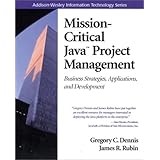
Average Reviews:

(More customer reviews)When I first started reading this book, I was impressed, until I got to Chapter 3. This is where the book trickles off to a generalized Java advertisement peppered with good management practices which can be appliedto any given development language or integrated development environment(IDE) out there, such as C++, Powerbuilder, VB, Delphi, and newer IDEs suchas Visual Interdev, C++ builder and JBuilder, none of which are adequatelytreated in this book.
What bothered me in particular was that thecopyright is 1999 but the authors elaborate on Java projects managed in1995-1997. Thus, for the less technologically savvy companies out theregiving Java a first look, this book may be useful, but for the rest of uswho have, essentially, tackled or are preparing to tackle similar problems,this book serves as a general guide to good Anderson-ish managementpractice. From this book one may glean tidbits of useful development ideas,such as how to embark on the installation of 3-tier or n-tier Java systems,but there remains a curious, more likely intentional, omission of projectmanagement details that matter.
I expect managers out there to havealready addressed similar issues with respect to large-scale developmentinitiatives, specifically, staffing requirements, cross-training ofexisting personnel, capacity planning (not mentioned), performance metrics(glossed over) and hardware considerations (again glossed over) whichseriously determine the success or failure of a Java-based developmentinitiative. None of these are discussed in detail enough to warrant a studyof this book.
The strongest case study found in this book is the largest,albeit dated, system which the authors seemed to have managed first-hand,and which you'll find in Chapter 2. Extensive treatment of Javadeficiencies and tackling the learning curve are covered, but may be lessapplicable to the JDK 1.2 (now officially JDK 2) since many developers havesince brought
themselves up to speed in Java and have engaged in at leastminimal cross-training.
Pros:
1. Chapter 2 (the project on which theauthors apparently worked, thus relevant) 2. Chapter 8 (a noble intro toconversion) 3. Chapter 9 (risk management, developing with an evolvingstandard - bad idea, but mentioned) 3. Chapter 14 (a good summary of Javaperformance problems encountered) 4. Good general management advice 5. Oneof the few books to tackle the subject 6. Specifically mentionsPowerbuilder/C++ implementation (surprised to see it) 7. Useful projectpost-mortems 8. Treatment of cross-training.
Cons:
1. The...but-we-got-it-to-work tone of items 1, 2, 3 above 2. Chapter 3,4,5(fluffy references to other Java projects lacking sufficient detail) 3.Chapter 6, 7 (Browser compatibility and "Java isn't a fad" peptalk) 4. PR-rich e.g. no pointers, easier than C++, portable,multiplatform, secure, robust 5. Copyright 1999, Case studies: 1995-1997(using pre JDK 1.1), thus nearly making the book obsolete 6. Utter lack ofuseful detail or omission such as: a. Analysis of the competition e.g.Microsoft and their implementation of COM/DCOM architecture b.Transaction servers/hardware and scalability of three-tier systems c.Project performance metrics, concurrency testing, bandwidth d.Distributed implementations and related problemse. The reporingdeficiencies of Java (after finding a third-party, success!) f. CastingJava's third-party vendor and widgets in such a favorable light g. Theemerging CORBA dialects and "factions" which may dilute Java'sstrength as the preferred distributed language h. The muddling oflanguage vs. and integrated development environment (IDE). VB and PB weremeant to remove C++ complexity for developers, but Java, by itself, isstill a low-level language NOT a 4GL, thus one might expect at least abrief discussion of vendor selections in this area such as Visual Cafe,Jbuilder, J++, Sun's IDE, but there are few except mention of Unix-based orproprietary, home-grown tools.
Click Here to see more reviews about: Mission-Critical Java(TM) Project Management: Business Strategies, Applications, and Development
Product Description:
As a guide to the benefits and drawbacks of deploying Java across the enterprise, written by two experts with experience in leading a large-scale Java development project, this book arms IT executives and managers with the ability to determine how Java fits into their corporate strategy.
Want to read more honest consumer review about Mission-Critical Java(TM) Project Management: Business Strategies, Applications, and Development now ?

0 comments:
Post a Comment